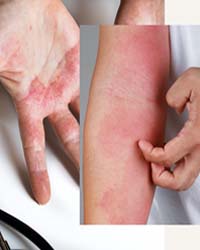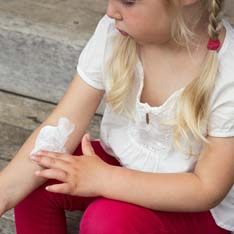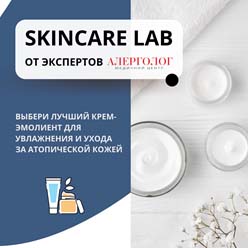Atopic dermatitis
-
in Diagnostics

Eczema is a general term for skin conditions that resemble rashes. Among several types, the most common is atopic dermatitis, which is a chronic skin disease. It is caused by an allergic reaction. "Atopic" describes a hereditary predisposition to the development of dermatitis, asthma and pollinosis. "Dermatitis" means that the skin is red and itchy.
HISTAMINE Eczema is an "atopic" disease that is combined with problems such as allergic rhinitis, asthma and food allergies. Atopics have a genetic predisposition to produce a type of antibody called IgE, which causes allergic reactions in various parts of the body—eyes, nose, lungs, intestines, and skin. These antibodies are thought to trigger atopic dermatitis by causing the release of histamine. Healthy skin helps retain moisture and protects you from bacteria, irritants, and allergens. Eczema is associated with a gene change that affects the skin's ability to provide this protection. The skin becomes more vulnerable to the world of allergens, which can penetrate it and cause intense inflammation and itching.
DIAGNOSTIC OF ATOPIC DERMATITIS
The diagnosis of atopic dermatitis is based on an examination of the lesions, recognition of the four typical phases of eczema, and possibly microscopic examination of a skin sample. The doctor asks where on the body the eczema started, when it appeared, how it progresses (for example, does it occur on vacation?), is it related to nutrition, what is the patient's professional environment, hobbies (sports, needlework , gardening, etc.), the type of clothing worn, medications taken, toiletries and cosmetics, the presence of an allergic reaction, etc.
Find out the price of an allergist-dermatologist consultation here.
The main step for further treatment of AD is to find out the cause of the disease. Of course, hereditary factors play a role, but there is a trigger point for exacerbation. Very often these are food products or inhaled allergens. Therefore, there are several tests that allow you to determine the cause of the development of atopy. The first step is screening - tests that allow the concept of the further course of the search for allergens - among food products or among those allergens that a child or adult inhales. These tests are called FX 5 and Phadiatop. The second step is a stool test. At this stage, it is necessary to see whether what the patient eats is completely digested. And then, depending on the first results, the doctor prescribes extended panels, where every product or component of house dust is already examined, for example. 
At the "Alergolog" medical center, we offer complex diagnostics in the "Atopy" package, which includes:
Inhalation allergy screening "Phadiatop" 8 allergy components (d1 Dermatophagoides pteronossinus mite, e1 cat, e5 dog, g6 timothy pollen, g12 rye pollen, m2 Cladosporium herbatum, t3 birch pollen, w6 wormwood pollen), Food allergy screening "fx 5 " (f1 egg protein, f2 cow's milk, f3 cod, f4 wheat, f13 peanut, f14 soybean), specific IgE to the mold Malassezia, Genetic risk of developing atopic dermatitis and ichthyosis (FLG R501X, FLG 2282delCAGT) by PyroMark pyrosequencing method Q24 /Only venous blood/.
HOW TO PREVENT AGGRAVATION OF ATOPIC DERMATITIS
Taking into account dryness, atopy and the combing reflex, specialists have discovered a new method of treatment, namely interaction with the "microbiome" of the skin. On skin prone to atopic dermatitis, the protective barrier of the microbiome is unbalanced. In this way, new prebiotics for the skin that alleviate the manifestations of dermatitis were developed. The latest unprecedented clinical research has found that the use of emollients during the first three weeks of life reduces the risk of developing atopic dermatitis by 50%.

SKINCARE LAB: GUIDE TO CREAM EMOLLIENT
For your convenience, "Allergologist" specialists have created a guide to emollient creams for daily care and treatment of adult and children's atopy.



